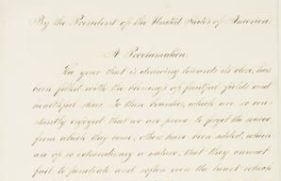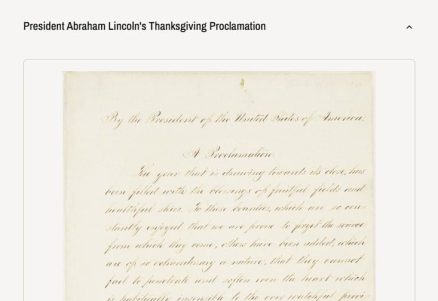
President Abraham Lincoln's Thanksgiving Proclamation
Civil War and Reconstruction (1850-1877)
A National Archives Foundation educational resource using primary sources from the National Archives

Published By:
Historical Era:
Thinking Skill:
Bloom’s Taxonomy:
Grade Level:
This activity can be used to learn more about the Thanksgiving holiday in the United States, including how Presidents and Congress create national holidays, or in a unit on a divided nation and the Civil War. Students may work individually or in small groups. For grades 5-8. Approximate time needed is 30 minutes.
Begin by introducing the history of Thanksgiving in America, from the 1621 Thanksgiving in Plymouth Colony to the 1863 Thanksgiving Proclamation. The following additional background information may be useful:
Thanksgiving has been a national holiday since 1863. Its origins among the English in America, of course, go back to the 17th century. While the traditional story of the “First Thanksgiving” has been reexamined to include multiple perspectives, a well-documented Thanksgiving took place at Plymouth, Massachusetts, over three days in November 1621. Governor William Bradford of the Plymouth Colony organized a celebratory feast and invited the Wampanoag who had assisted the colonists in numerous ways over the previous years.
The concept of giving thanks after the harvest continued in the colonies in the 17th and 18th centuries. During the American Revolution, the Continental Congress designated days of thanksgiving. On October 3, 1789, President George Washington issued the first Thanksgiving proclamation by the national government designating for “the People of the United States a day of public thanks-giving” to be held on “Thursday the 26th day of November.”
In 1846 Sarah Josepha Hale, a writer and editor of Godey Lady’s Book began her campaign for a national day of Thanksgiving. Hale wrote letters to presidents and politicians, and editorials and articles advocating for a day of Thanksgiving celebrated by all states on the same day, believing that a unifying day could help ease growing tensions and divisions between the north and the south. In September 1863, Hale wrote to both President Lincoln and Secretary of State William Seward urging them to declare a national day of Thanksgiving.
On October 3, 1863, President Lincoln issued a Thanksgiving Proclamation. With this proclamation, the United States had a national day of Thanksgiving. Presidents since Abraham Lincoln have issued a Thanksgiving Proclamation every year, appointing the day set by Lincoln – the “last Thursday in November” as the official day of national Thanksgiving. In 1939, President Franklin D. Roosevelt moved the holiday to the third Thursday of November to lengthen the Christmas shopping season. After protests from across the nation, Congress established the Federal Thanksgiving Day holiday, following the passage of a joint resolution, H.J. Res. 41, by the House of Representatives on October 6, 1941, declaring the “last Thursday in November a legal holiday.” The Senate then passed an amendment “making the fourth Thursday in November a legal holiday.”
Ask students to begin the activity and model document analysis with Lincoln’s 1863 Thanksgiving Proclamation that created a national holiday.
The language in Lincoln’s 1863 Thanksgiving Proclamation may be a challenge for students to read and comprehend. An excerpt of the document is provided for students:
I do therefore invite my fellow citizens in every part of the United States, and also those who are at sea and those who are sojourning in foreign lands, to set apart and observe the last Thursday of November next, as a day of Thanksgiving and Praise to our beneficent Father who dwelleth in the Heavens. And I recommend to them that while offering up the ascriptions justly due to Him for such singular deliverances and blessings, they do also, with humble penitence for our national perverseness and disobedience, commend to His tender care all those who have become widows, orphans, mourners or sufferers in the lamentable civil strife in which we are unavoidably engaged, and fervently implore the interposition of the Almighty Hand to heal the wounds of the nation and to restore it as soon as may be consistent with the Divine purposes to the full enjoyment of peace, harmony, tranquillity and Union.
The activity will ask students to carefully study the passage and answer:
Next, students will see an engraving by Thomas Nast’s called “The Union Altar.” It was published in Harper’s Weekly on December 3, 1863. The engraving reflects ideas and sentiments expressed in the 1863 Thanksgiving Proclamation and students will be asked to explain three ways that it reflects the words in Lincoln’s Proclamation.
Students complete the activity by clicking “When You’re Done” and sharing why they think the national holiday of Thanksgiving is important to the United States. Wrap up by leading a class discussion asking students to explain the connections they discovered between Lincoln’s Proclamation and Nast’s engraving.
In this activity, students will read a brief summary of the origins of Thanksgiving, then examine President Abraham Lincoln’s 1863 Thanksgiving Proclamation that created a national holiday. They will also study an 1863 engraving by Thomas Nast and connect the two documents, identifying how the engraving reflects the wording in the Proclamation. Students will conclude by sharing reasons why a national day of Thanksgiving has been important to the United States.
